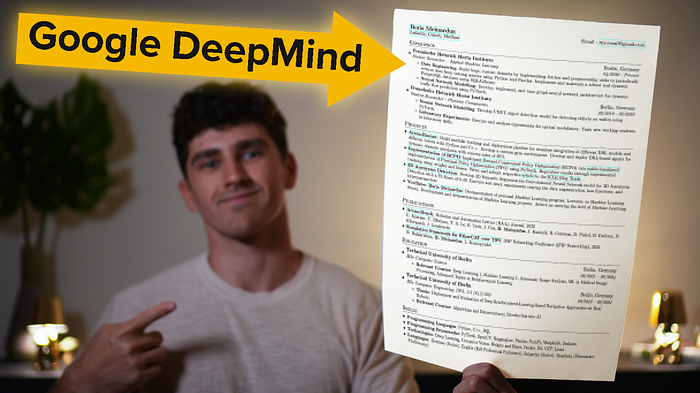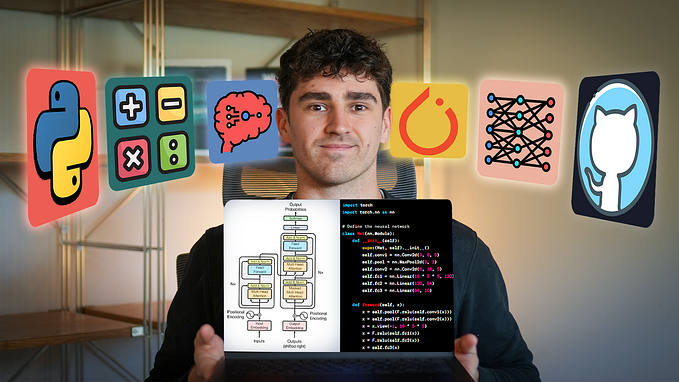You're reading for free via Boris Meinardus' Friend Link. Become a member to access the best of Medium.
This Simple Resume Got Me a Google DeepMind Interview
7 important tips that you can easily apply to your resume

Hey! Ever wondered what it takes to land machine-learning interviews at dream companies like Google DeepMind, Amazon, and Nuro?
Well, today, we’re gonna talk about the resume that got me internship interviews with these FAANG companies and I’ll be sharing with you seven important tips that you can easily apply to your resume. But that’s not all — stay tuned until the end, because we’ll then uncover the single most important reason that I got invited to the interviews. Let’s get started, shall we?
By the way, if you want me to help you directly with your specific resume, feel free to simply book a 1-on-1 call with me!
Tip 1 — Length of your resume
How long do you think it takes a recruiter to look at your resume?
It takes an average of 7 seconds.
Big tech companies receive hundreds if not thousands of applications every day, so, one of the simplest, yet most important tips right away is to not exceed one page for your resume.
Some absolute no-goes include adding obvious things like knowing how to use MacOS or Windows.
That’s like an English teacher saying he knows how to speak English…
Also, I’m sorry to tell you but the recruiters also don’t care about your hobbies.
We will later get to a simple question you can ask yourself to help you remove unnecessary information but also don’t add too much information in your education section. The companies hire you for your skills and experience, which might be the product of your education, but no real demonstration.
Try putting yourself in the shoes of your recruiter Joe. He has to go through hundreds of same-looking and boring resumes and only takes 7 seconds to glance over them. That means he will never read a dull summary section. Instead, he will directly look for the minimum requirements of skills.
So, place the skills section directly at the top and replace the summary.
This is/ was my resume:

You can see, that my Skills section was at the bottom, and I did still get the interviews, but I have already changed it for future applications.
Okay, Joe now sees you at least list the skills he is looking for.
You now need to briefly demonstrate those skills and convince him that your skills have somewhat of a substance. You need to show off your experience.
Ideally, you describe your actual internship or job experience first and then the projects, but if you have more and better experience with personal or open source projects, go with projects first and job experience second.
Then, if you have any, mention selected publications and finally your education section.
Tip 2 — The question to always ask yourself
The next tip is the simple question you should always ask yourself to not add irrelevant information.
So what?
Imagine Joe is reading a statement on your resume, and thinks to himself “So what?” That’s bad. You just wasted his precious seconds and, in the extreme case, he will move to the next resume.
For example, I added the courses Deep Learning 1 and Automatic Image Analysis.
So what?
What does this tell the recruiter? He, and you as well, have no idea what is taught in those courses. Instead, I demonstrate deep learning and computer vision knowledge via my experiences and projects.
So, also as a note for myself, once I have more experience to add to my resume, I will try to remove those mentioned courses and only include relevant information.
Tip 3 — Always include the important words
Now, to make it even easier for Joe to find the most relevant information, you can use bold text for important keywords but of course, don’t add too many because then once again nothing stands out.
Speaking of those important skills and keywords, the next tip is to be aware of your wording.
As mentioned your recruiter Joe or even the automatic resume scanner will look for certain keywords in a predefined list.
>> But Boris, how do I know which words specifically they are looking for??!
Well, we of course can’t say for certain, but we can look at the required qualifications in the target job description. There we can see some specific skills they are looking for which will very likely be important in your resume. And those can of course vary from listing to listing.
Tip 4 — Listing skills is not enough
Okay, as mentioned, after making it as easy as possible for your recruiter to find the relevant skills, you need to prove your skills.
You here need to find a good balance between technical details and abstraction because your recruiters are most likely no researchers themselves, but, over time, have learned what technical words are good and what are bad.

For example, here I mention I built a large and custom dataset. “So what?”
That, on its own, does not say much.
I then go ahead and explain how I did that, demonstrating and specifically mentioning the technical skills and frameworks I used to achieve that result, like implementing a certain module and database using Python, Pandas, and PostgreSQL.
Implementation of RCPO: Implement Reward Constrained Policy Optimization (RCPO) into stable-baselines3 implementation of Proximal Policy Optimization (PPO) using PyTorch. Reproduce results through experimental tracking using weights and biases. Write and submit respective article to the ICLR Blog Track.
Or here, I demonstrate the technical skill of experiment tracking and combine it with my ability to use a certain framework like weights and biases.
Develop 3D Semantic Segmentation Convolutional Neural Network model for 3D Aneurysm Detection with a F1-Score of 0.39. Execute and track experiments varying the data augmentation, loss functions, and hyperparameters.
Or when mentioning something like the F1 score, I show that I am aware of this particular metric and the process of evaluation in general.
Tip 5 — When possible, use numbers to show results
Speaking of the F1 score, the next tip is to always try to quantify your results whenever you can!
What do you think sounds more professional:
>> Develop a model with good performance…
Or
>> Develop a model with an F1-Score of 0.39
Or what do you think sounds better here:
>> Develop a DRL-based agent with a very high success rate
Or
>> Develop a DRL-based agent with a success rate of 95%
Numbers often make you seem more educated, and invested in the project, because you know the details of it.
Many metrics are also more intuitive for the recruiter. A success rate of 95% is very intuitive. An F1-Score of 0.39 is perhaps not that intuitive, but you get the point.
Tip 6 — Think beyond the resume itself
If you have done a good job in those first 7 or now even 20 seconds, Joe has deemed you worthy of his time and wants to know more about you.
Again, make it as easy as possible for him to learn more about you.
The next tip is to provide and embed links to LinkedIn, ideally even a personal website, blog posts, and more!
I actually have a YouTube video on how you can very easily create your own academic website. — Hehe, cheeky plug :)
That said, what he might want to see on your website, or directly linked on your resume, is an interesting blog post describing a project of yours. Sure you should also link to your GitHub, but it’s much more difficult to look at the code base to understand more about the project. Writing an accompanying blog post to the project just makes understanding your experience and skills much easier.
See the pattern here?
Try to make the life of the recruiter as easy as possible.
Tip 7 — Always be humble, but not this time
Now you might be thinking “But I don’t have any meaningful projects or work experience”. But that is not true. It’s all about how you sell yourself.
We all want to be humble and friendly, but this is competition. This is literally THE time to flex as much as possible and go into winning mode. Over exaggerate, but don’t lie! Once you’re in the interview, you might need to be able to back up claims.
Neural Network Modelling: Develop, implement, and tune graph neural network architecture for dynamic traffic flow prediction using PyTorch.
For example, “Develop, implement, and tune Graph Neural Network” sounds like I completed the full model, but I only really got started with the basic implementation and ran only preliminary experiments to figure out some basic settings. I didn’t tune the whole model to a production-ready version.
I mean, I did it in other projects and could explain how to do it in the interview, but we’re here talking about how to design your resume to get invited to an interview in the first place.
So, really, don’t undervalue yourself. Especially not with things like “Beginner” or even “intermediate” level Python skills. If you really have to, you can explain yourself later in the interview.
Why did I get invited?
Having a good-looking and well-formatted resume is very important, but won’t magically land you an interview. The recruiters are looking for specific skills they need for a specific project. They might consider multiple experiences from your applications, but in the end, your skillset needs to fit one project.
For my Google DeepMind internship, I applied for a research position in Multimodal Learning. That’s more or less what I knew about.
But luckily for me, at that time, RLHF was hyped, and the team wanted to use it in their research. That’s why they were interested in me, because of my additional experience with RL, especially my project where I reimplemented an RL paper. During the interview, we mainly talked about that little project!
The team at Amazon, on the other hand, was specifically interested in me because of my graph neural network modeling experience for traffic flow prediction.
That was pretty much the exact same thing they were researching in their group!
And Nuro was interested in a combination of both skills!
Autonomous navigation and graph neural networks. Because they are developing self-driving delivery cars and streets are represented as graphs.
I mean, I have no experience with recommender systems. Why would a team want to choose me?
All that means, look for job listings or people who would need you and your skills specifically!
Take your time and try to make your resume as fitting as possible following the tips I just shared.
That said, I applied to many job or internship openings using the standard application route, and LinkedIn. I applied to a lot of different openings I just wasn’t the best fit for. Doing that still got me the mentioned interviews at Amazon and Nuro, but the success rate for landing interviews was not all too high.
The real reason I got my Google DeepMind interview, besides a good resume, was that I didn’t follow this conventional application approach! This, by the way, also got me my current student researcher position working for my Ex-Meta Professor!
This other approach had a much higher success rate, so you will most likely want to read the next blog post where I share what this approach is and how to apply it step-by-step!
Thanks for reading. Ba-Bye!
P.S.: If you like this content and paper reviews, you can also have a look at my YouTube channel, where I post similar content but with more neat visuals!










